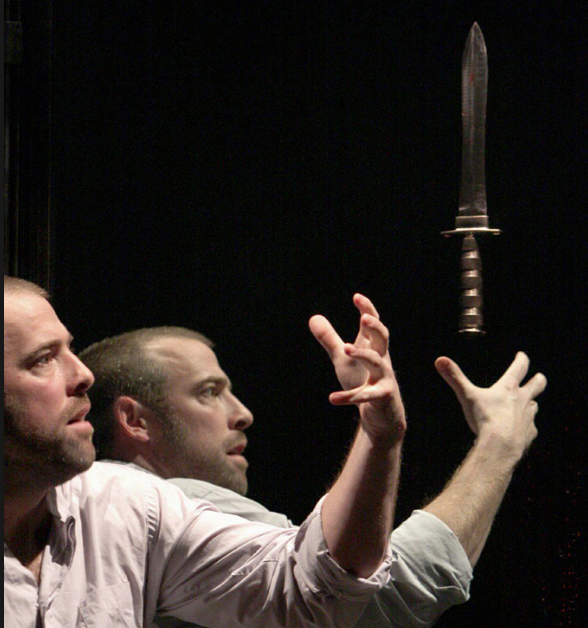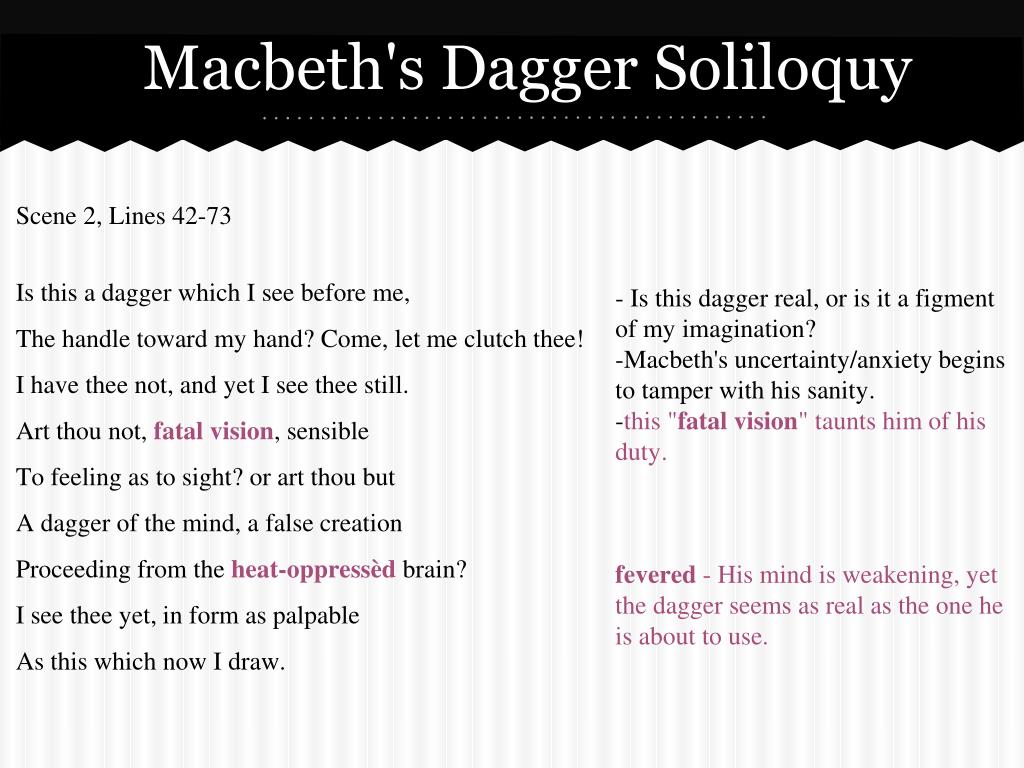Macbeth Is This A Dagger Monologue
Macbeth Is This A Dagger Monologue - Macbeth speaks this famous soliloquy when he is taken over by his guilt and growing insanity for killing duncan. The speech, “is this a dagger which i see before me” is about the supernatural in macbeth’s life. I have thee not, and. Come, let me clutch thee. Is this a dagger which i see before me, the handle toward my hand? It was originally published in 1623. Come here, dagger, and let me grasp you. His imagination brings forth the. Is this a dagger i see in front of me, with its handle aimed toward my hand? It begins after midnight on the day of the king's arrival at inverness, with a scene devoted to the preliminaries of the murder, and closes late in.
Macbeth speaks this famous soliloquy when he is taken over by his guilt and growing insanity for killing duncan. Is this a dagger i see in front of me, with its handle aimed toward my hand? I have thee not, and. Is this a dagger which i see before me, the handle toward my hand? Come here, dagger, and let me grasp you. The speech, “is this a dagger which i see before me” is about the supernatural in macbeth’s life. It was originally published in 1623. It begins after midnight on the day of the king's arrival at inverness, with a scene devoted to the preliminaries of the murder, and closes late in. His imagination brings forth the. Come, let me clutch thee.
Is this a dagger i see in front of me, with its handle aimed toward my hand? It was originally published in 1623. His imagination brings forth the. Come, let me clutch thee. Come here, dagger, and let me grasp you. It begins after midnight on the day of the king's arrival at inverness, with a scene devoted to the preliminaries of the murder, and closes late in. Is this a dagger which i see before me, the handle toward my hand? I have thee not, and. Macbeth speaks this famous soliloquy when he is taken over by his guilt and growing insanity for killing duncan. The speech, “is this a dagger which i see before me” is about the supernatural in macbeth’s life.
Macbeth Dagger Soliloquy
Is this a dagger i see in front of me, with its handle aimed toward my hand? Macbeth speaks this famous soliloquy when he is taken over by his guilt and growing insanity for killing duncan. Come here, dagger, and let me grasp you. I have thee not, and. It begins after midnight on the day of the king's arrival.
Lesson 14 Macbeth s soliloquy Macbeth Act 2 Scene 1 Macbeth’s
The speech, “is this a dagger which i see before me” is about the supernatural in macbeth’s life. His imagination brings forth the. Come, let me clutch thee. Come here, dagger, and let me grasp you. Is this a dagger i see in front of me, with its handle aimed toward my hand?
Is this a dagger, which I see before me? // Macbeth // Shakespeare
Is this a dagger i see in front of me, with its handle aimed toward my hand? Come here, dagger, and let me grasp you. Come, let me clutch thee. The speech, “is this a dagger which i see before me” is about the supernatural in macbeth’s life. It was originally published in 1623.
Macbeth Dagger Soliloquy
Come, let me clutch thee. Is this a dagger i see in front of me, with its handle aimed toward my hand? The speech, “is this a dagger which i see before me” is about the supernatural in macbeth’s life. It begins after midnight on the day of the king's arrival at inverness, with a scene devoted to the preliminaries.
PPT Macbeth Act II PowerPoint Presentation, free download ID2191080
Is this a dagger which i see before me, the handle toward my hand? Macbeth speaks this famous soliloquy when he is taken over by his guilt and growing insanity for killing duncan. I have thee not, and. Come, let me clutch thee. The speech, “is this a dagger which i see before me” is about the supernatural in macbeth’s.
Macbeth Dagger Monologue YouTube
His imagination brings forth the. It was originally published in 1623. I have thee not, and. Is this a dagger which i see before me, the handle toward my hand? Come, let me clutch thee.
(DOC) Macbeth's Dagger Monologue Geza Kallay Academia.edu
It begins after midnight on the day of the king's arrival at inverness, with a scene devoted to the preliminaries of the murder, and closes late in. His imagination brings forth the. Macbeth speaks this famous soliloquy when he is taken over by his guilt and growing insanity for killing duncan. It was originally published in 1623. Come here, dagger,.
PPT Macbeth Act II PowerPoint Presentation, free download ID2191080
I have thee not, and. The speech, “is this a dagger which i see before me” is about the supernatural in macbeth’s life. It was originally published in 1623. It begins after midnight on the day of the king's arrival at inverness, with a scene devoted to the preliminaries of the murder, and closes late in. Macbeth speaks this famous.
Macbeth Dagger Soliloquy
His imagination brings forth the. Is this a dagger which i see before me, the handle toward my hand? Come here, dagger, and let me grasp you. The speech, “is this a dagger which i see before me” is about the supernatural in macbeth’s life. Come, let me clutch thee.
Shakespeare explained Macbeth Act II Scene 1 "Is This A Dagger
The speech, “is this a dagger which i see before me” is about the supernatural in macbeth’s life. It was originally published in 1623. Is this a dagger which i see before me, the handle toward my hand? Is this a dagger i see in front of me, with its handle aimed toward my hand? I have thee not, and.
It Begins After Midnight On The Day Of The King's Arrival At Inverness, With A Scene Devoted To The Preliminaries Of The Murder, And Closes Late In.
Macbeth speaks this famous soliloquy when he is taken over by his guilt and growing insanity for killing duncan. I have thee not, and. Is this a dagger which i see before me, the handle toward my hand? Come, let me clutch thee.
The Speech, “Is This A Dagger Which I See Before Me” Is About The Supernatural In Macbeth’s Life.
Come here, dagger, and let me grasp you. His imagination brings forth the. Is this a dagger i see in front of me, with its handle aimed toward my hand? It was originally published in 1623.









